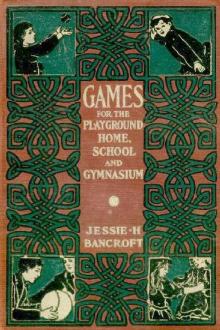Games for the Playground, Home, School and Gymnasium by Jessie Hubbell Bancroft (top novels of all time .txt) 📕

- Author: Jessie Hubbell Bancroft
- Performer: -
Book online «Games for the Playground, Home, School and Gymnasium by Jessie Hubbell Bancroft (top novels of all time .txt) 📕». Author Jessie Hubbell Bancroft
10 to 30 or more players.
Playground; gymnasium; schoolroom; parlor.
This game is a great favorite with children, and may be made an opportunity for much sport with youths and older players.
All but two of the players form a ring by clasping hands, the inclosure serving as the garden. Within this one of the odd players who is assigned to be the scamp takes his place. The other odd player, the gardener, moves around on the outside of the circle.
The gardener calls to the scamp inside, "Who let you in my garden?" and the scamp answers, "No one!" whereupon he starts to run away, the gardener chasing him. The gardener must take the same path followed by the scamp in and out under the arms of the players, who must lift their hands to let them pass. The gardener must also go through all of the movements performed by the scamp, who may jump "leapfrog" over any player in the circle, turn somersaults, crawl between the legs of a circle player, double unexpectedly on his path, circle around one of the players, or resort to any other device for making the chase difficult. If the scamp be caught, he becomes gardener, and the gardener joins the circle. The former scamp, now gardener, chooses a new scamp to go into the circle.
Should the gardener fail to follow in the exact path of the scamp, or to perform any of the feats or antics of the scamp, the gardener must at once join the ring, and the scamp then has the privilege of choosing a new gardener.
FOR THE SCHOOLROOM.—This game may be played by the entire class forming a circle around the room as close to the seats as possible to leave room for the chase outside the circle. Where seats can be turned up, this should be done, to give the runners opportunity to cross and recross the center space easily. The scamp, however, may vault over seats in his efforts to escape or delay the gardener.
GOING TO JERUSALEM10 to 60 or more players.
Parlor; gymnasium; schoolroom.
A row of chairs is placed in the center of the room, so that they face alternately in opposite directions, one chair to one side, the next to the opposite side, etc. There should be one chair less than the number of players. The game is most interesting when played with musical accompaniment.
The game starts with all the players seated in the row of chairs except one. This odd one is the leader, and his first object is to recruit the players for his trip to "Jerusalem." He carries a cane and walks around the row repeating, "I'm going to Jerusalem! I'm going to Jerusalem!" in singsong. Every few moments he stops at his discretion and knocks with his cane on the floor behind the chair of some player. Immediately the player thus summoned rises from his chair and follows the leader, sometimes having a lively scramble to encircle the row of chairs and catch up with him. The next player knocked for follows this one, and so on, until all are moving around in single file. The leader may reverse his direction at pleasure. This general hurry and confusion for the start may, with a resourceful leader, add much to the sport of the game.
When the players are all recruited, they continue to march around the row of chairs, the main object of the game being the scramble for seats when the music stops, or upon some other signal to sit if there be no music.
The musician will add to the interest of the game by varying the time of the march from slow and stately time to "double quick." At any moment, after all the players are marching, the music may stop suddenly. Whenever this happens, the players all scramble for seats. There will be one odd player left without a seat. This player is thenceforth out of the game and retires to one end of the room, taking with him one of the chairs. This continues until there are only two players encircling one chair, and the one who secures it wins.
Where two players reach a chair at nearly the same time, the chair belongs to the one who first reached it, or who is sitting more fully on it. Sitting on the arm of a chair does not count, nor touching it with the hands or knees.
FOR THE GYMNASIUM.—When played in a gymnasium, a row of gymnasium stools may be used instead of chairs, and the gathering up of the players omitted, the game starting with the stools empty.
FOR THE SCHOOLROOM.—When played in the schoolroom, the game starts with all of the players ready to march, the first part of the game, in which they are recruited, being omitted. The class should march in serpentine form up one aisle and down the next, etc., instead of encircling a row of seats. There should be for a large class from one to six less seats than the number of players. For instance, one seat should be counted out in each row or each alternate row. The seat that is not in play may be designated by turning it up, if of that variety, and by placing a book on the desk belonging to it.
Wherever played, the game may be carried on without music, simply by the leader or teacher beating time and stopping when players are to sit; or he may give a signal or a command to "Sit!"
GOOD MORNING10 to 60 or more players.
Schoolroom; parlor.
This is a very pretty sense-training game,—cultivating discrimination through the sense of hearing. Little children are very fond of it, and it is most interesting and surprising to note the development of perceptive power through the playing of the game.
One player blinds his eyes. He may do this by going to a corner of the room and facing the wall, with his hand over his eyes; or a very pretty method is to have him go to the teacher or leader, with his face hidden in her lap, and her hands on either side of his head, like the blinders of a horse.
The teacher then silently points to some other player in the class, who rises at once and says, "Good morning, David!" (or whatever the child's name may be). The little guesser, if he has recognized the voice, responds with, "Good morning, Arthur!" (or other name). If he does not guess the voice after the first greeting, the child may be required to repeat it, until the guesser has had three trials. Should he fail on the third trial, he turns around to see who the player was, and changes places with him. If he names the right player, the guesser retains his position until he fails to guess the voice of the one greeting him, one player after another being required to stand and give the greeting "Good morning!"
When pupils have become somewhat proficient in the guesser's place, the others should be required to change their seats after the guesser has blinded his eyes, so that he will not be assisted in his judgment by the direction from which the voice comes, which is very easily the case where the other players are in their accustomed seats.
Of course the greeting will be varied according to the time of day, being "Good afternoon!" or "Good evening!" as may be appropriate. Occasionally, in a school game, a pupil from another room may be called in. Should a strange voice be heard in this way, the little guesser is considered correct if he answer, "Good morning, stranger!"
GUESS WHO10 to 30 or more players.
Playground; gymnasium; parlor; schoolroom.
Where there are more than ten players, it is desirable to have them separated into several groups. Each group has a leader, and lines up in rank (side by side), with the leader in the middle. One odd player stands in front of the line, facing it.
"Have you seen my friend?"
"No."
"Will you go and find him?"
"Yes."
"Put your finger on your lips and follow me!"
The player in front then turns around and, with finger to his lips, runs to another part of the ground, all of the row falling in behind and following him, each player with finger on lips. When they have reached a new position, the first player stops with his back to the line, which re-forms in a new order under the direction of its leader, so that the players do not stand in the same relative positions as when the odd player faced the line. One player from the row selected by the leader now steps forward behind the odd player and says, trying to disguise his voice, "Guess who stands behind you!"
If the odd player guesses correctly, he retains his position, turns around, and the dialogue begins over again. If the guess be wrong, the one who is It changes places with the one whose name he failed to guess.
GYPSY5 to 10 players.
Indoors; out of doors.
This is one of the traditional dramatic games, obviously an abbreviated form of Mother, Mother, the Pot Boils Over!
One player is selected for gypsy, and one for the mother. The others are children. The gypsy remains in hiding while the mother says to her children, pointing to the different ones in turn:—
To keep good house while I am gone;
You and you, but specially you,
Or else I'll beat you black and blue."
The mother then goes away and blinds her eyes. During her absence the gypsy comes in, takes away a child, and hides her. The gypsy repeats this until all of the children are hidden. The mother returns and finds her children gone, whereupon she has to find them. When all have been found and brought back home, all chase the gypsy.
HANG TAG10 to 100 players.
Playground; gymnasium.
One player is It, or chaser, and changes places with any other player whom he can touch (tag). In this form of the game, however, any player may escape being tagged by hanging from anything overhead which will enable him to lift his feet from the floor. When played out of doors, where there are trees, players will naturally jump to catch hold of the branches of the trees. In a playground or gymnasium pieces of apparatus may be used for the same purpose. A player is considered immune if, instead of hanging by his hands, he throws himself across some obstacle, such as a fence, which enables him to lift his feet from the ground.
The game is very uninteresting if players each choose a place and remain close to it in the intervals of the game; but it may be made full of sport if each will take risks and run from point to point, taunting the one who is It by going as near him as possible, or allowing him to approach closely before springing for the overhead support. The one who is It may not linger near any player to





Comments (0)